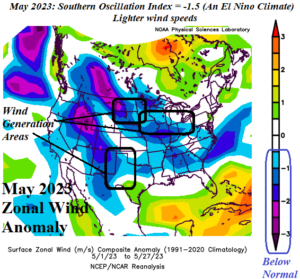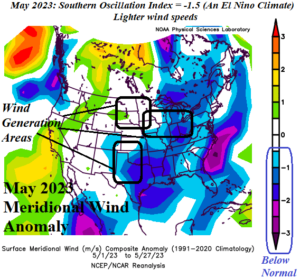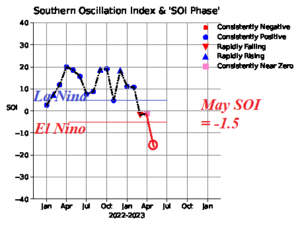Seasonal Hurricane Forecast Summary and Watching Southeast U.S. Coast for Development
05/26/2023, 8:44 am EDTUpdated North Atlantic Basin 2023 Tropical Cyclone Outlook Revised More Dangerous
06/01/2023, 5:30 pm EDT
Fig. 1: May 2023 U.S. zonal wind anomalies indicate widespread below normal wind speeds.

Fig. 2: May 2023 U.S. meridional wind anomalies indicate widespread below normal wind speeds.

Fig. 3: Monthly southern oscillation index shifts out of a persistent La Nina signature to an El Nino-like negative value in May.
Discussion: During May 2023 U.S. wind power generation was below normal on both zonal and meridional directional scales (Fig. 1-2). Wind power generation areas across the Upper Midwest/Midwest U.S. and southwest Great Plains/Western Texas were each affected by the lighter than normal wind speed regimes. The macro-scale driver of the lighter wind speeds was an El Nino-like climate as defined by a vigorous negative phase of the southern oscillation index (Fig. 3). Although a formal El Nino onset has not yet been announced, the global climate pattern shifted strongly in that direction during May driven by a powerful transient Madden Julian oscillation (MJO) episode across the equatorial Pacific. During El Nino climate patterns wind speeds in the U.S. wind power generation areas is typically lighter than normal due to lower pressure in the subtropics and higher pressure in the middle/higher latitudes and weaker jet stream patterns. The climate pattern and actual ENSO phase are not always exactly correlated. During the 2020-23 La Nina, multivariate ENSO index (MEI) identifying the atmospheric reaction to equatorial Pacific SSTA was consistently in La Nina phase while the monthly Nino34 SSTA which traditionally determines ENSO phase was in La Nina phase about 75% of that timeframe (and neutral phase 25%). U.S. wind power generation during the anticipated El Nino ahead is likely below normal for the second half of 2023 through the first quarter of 2024.
